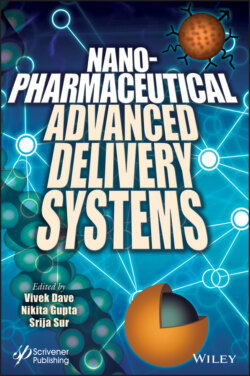Читать книгу Nanopharmaceutical Advanced Delivery Systems - Группа авторов - Страница 31
1.7 Application of Lipid-Based Nanocarriers 1.7.1 Application in Drug Delivery
ОглавлениеLiposome drug delivery has created a greater opportunity to formulate a large variety of drugs, which causes difficulty during delivery. Various kinds of marketed formulations are present in the form of liposomes such as Atragen, Amphotec, Ambisome, Amphocil, Abclcet, ALEC, Avian retrovirus vaccine, DaunoXome, Depoeyt, Doxil, Estrasorb, Evacet, Fungizone, Mikasome, Nyotran, Topex Br, Ventus, VincaXome, etc. [119].
Doxil (ALZA, Mountain View, CA), which was approved by US-FDA in 1995, was the first liposomal delivery to anti-cancer medication for breast cancer. Doxil is a PEGylated liposomal nanoformulation of encapsulated doxorubicin at the range of 75 nm [120]. Recently, a research study done by Dong et al. reported that PEGylated liposome doxorubicin was prepared by microfluidic mixing in the size range of 50- and 70-nm diameter on tumor retention and penetration [121].
Hua et al. (2013) reported that celecoxib in the form of hyaluronate gel improves the therapeutic benefit of lipid nanocarriers for pain management [122]. Hua and Cabot (2013) discussed in their study that Endomorphin-I opioids in the form of NPs (Polysorbate 80 coated NPs) enhance the penetration across BBB and improve therapeutic benefits. In addition, few studies mentioned that application of liposomal preparation for the administration of anti-retroviral drugs (ARVs), such as stavudine and zidovudine, was specifically targeted for HIV-related CNS diseases [123].
The SLNs are also very ideal for parenteral delivery due to their tiny size, lipidic nature, and high storage capacity after sterilization [124]. SLN intravenous administration is favored for the delivery of viral and non-viral genes because they can circulate quickly in the blood, for example, doxorubicin-loaded stealth and nonstealth SLNs. It was noticed that nonstealth nanoparticles are present at a lower concentration than stealth nanoparticles after 24 hours of intravenous administration [125].
Researchers demonstrated that SLNs by nasal routes depicted extremely positive results, e.g., SLNs of donepezil (DPL) for delivery to brain via the nasal route. The oral delivery was not promising in delivering DPL into the brain due to its hydrophilicity, several cholinergic side effects, hepatotoxicity, and first-pass metabolism [126].
Fatouh et al. (2019) achieved sustained drug release and improved corneal penetration of Natamycin using solid lipid nanoparticles (NAT-SLNs). The result confirms the desirability of using NAT-SLNs as an ophthalmic delivery system for sustained, antifungal activity and also as an alternative to conventional drops in the treatment of deep corneal fungal keratosis [127].
Khosa et al. (2018) proposed that NLC formulations seem to be preferable to SLNs due to their smaller particle size and higher drug loading capabilities [128]. Moreover, few experiments with NLC formulations for drug delivery through the BBB have been performed. Song et al. (2016) developed Arginine-glycineaspartic acid peptide (RGD)-modified temozolomide NLCs and found them to possess higher cytotoxicity and tumor inhibition compared to the parent drug solution [129].
Antiretroviral medications can also be integrated in an SLN to improve effectiveness, reduce side effects, and promote the movement of drugs in the brain by crossing the blood-brain barrier [130]. SLN scan raises the gradient of local concentration of drugs and enhances the transfer of drugs to the brain via endocytotic pathways. When incorporated with SLNs, the bioavailability of antiretroviral drugs is improved in the brain.
SLNs demonstrate improved drug release profiles, including continuous and controlled release of pharmaceutical agents. Doxorubicin with polysorbate 80 nanoparticles also depicted 40% cure in rats in glioblastomas transplanted intracranially [130, 131]. The nanoemulsions are used as vehicles to deliver the bioactives, which otherwise suffer from poor bioavailability and patient noncompliance [132]. Nanoemulsion-based vaccine delivery provides positive outcomes against HIV infection and shows good prognosis when the desired site of activity is oral or nasal mucosa.
Crystalline mesophases may also have a positive impact on drug development properties, such as kinetics of degradation and drug release, and comprehensive investigation of disordered materials (structure, dynamics, and thermodynamics) for the stability of the pharmaceutical ingredients [133, 134]. It has been shown that development of crystalline mesophases imparts high drug payload, provides thermodynamic solubility, and improves the absorption of poorly soluble drugs very effectively [135]. At the periods, mesophases could yield similar benefits like amorphous materials, i.e., improved apparent solubility and higher dissolution rates compared to crystalline forms, while reducing the risk of physical instability and solution precipitation compared to amorphous forms [136].
In the delivery of therapeutic agents to the CNS, lipid-based nanocarriers are considered a promising drug delivery method. Due to the natural potential of lipophilic materials to target the BBB, lipid-based nanocarriers are expected to be effective for CNS therapeutic drug delivery. Lipid nanoparticles are considered bio-acceptable and biodegradable, which makes those less toxic and more desirable for brain targeting. The application of lipid nanocarriers as targeted drug delivery systems is provided with several improvements, including enhanced storage stability, easy production without organic solvent, the potential of steam sterilization, lyophilization, and large-scale production [137–139].
